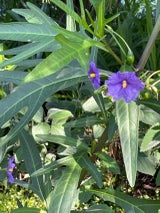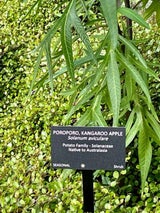- In the Garden
- >
- Gardens
- >
- Gardens A-D
- >
- Australia & New Zealand Garden
- >
- Solanum aviculare
Solanum aviculare
Common name: Kangaroo Apple
Solanum aviculare is a small to medium evergreen shrub native to Australia. Kangaroo Apple is a colonizing plant: fast-growing, short-lived (5 to 6 years), and appearing after fire or on a disturbed site. VanDusen lost many of its eucalyptus trees in the Southern Hemisphere Garden from an extreme cold spell last winter (2021-22). Kangaroo Apple has been planted scattered about this area. This spreading shrub is easy on the eye and an effective short-term replacement.
Its flowers are up to 4 cm/1.5 in across and bloom spring and summer. They are an eye-catching bluish-violet with a deep violet star-shaped marking at the base and bright yellow anthers. Native bees visit the flowers and aid fertilization by buzz fertilization. The bees sit on top of the anthers and vibrate their wings. This causes pollen to lift out of the upright anthers and stick to the bees’ bodies. The pollen is carried to other flowers and cross pollination takes place. Egg-shaped berries about 2 cm/.75 in long follow the flowers. Initially they are green then age to orange-red.
The genus name Solanum is from the Latin ‘solamen’ for solace, referring to the narcotic properties of some species. The common name ‘Kangaroo Apple’ comes from the kangaroo foot-print-like shape of the deeply lobed leaves and the fruit. For thousands of years indigenous Australians and Maoris have used the Kangaroo Apple as a food source and in their medicine. Only the ripened fruit can be eaten - every other part of the plant is poisonous. Kangaroo Apple belongs to the Solanaceae (Potato family) - a family that evolved early in the history of plants.
The pictures were taken in the Southern Hemisphere Garden in September, 2022 by Hughie Jones, who also wrote the text.






